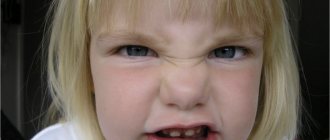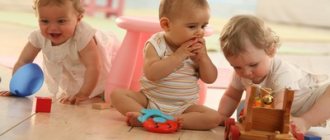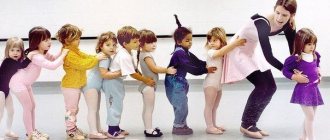Features of moral development of young children
At an early age, children begin the process of moral personal development, which
- cognitive (information) aspect – knowledge and ideas about moral concepts, standards, norms, rules, personal moral qualities;
- emotional and motivational aspect - moral feelings, social and moral emotions, moral motives and preferences, moral assessment and self-esteem;
- behavioral aspect - moral actions and deeds, moral habits, i.e. implementation of moral norms and requirements.
The interrelation of cognitive, affective and behavioral components in the personal sphere determines the unity of moral consciousness and behavior . These components only begin to form at an early age. This is facilitated by children’s desire to collaborate with adults and their high imitation.
In early childhood, the child begins to understand certain moral rules of behavior . Such an understanding is limited to a specific situation, the framework of the child’s visual and effective thinking. Understanding the rules and norms of behavior is based on the child’s own experience, when he realizes the negative consequences of breaking the rules and the positive consequences of following them. In this regard, from an early age, an adult must justify the demands put forward, based on specific life situations and the child’s own experience. In children's active vocabulary there are few words denoting moral categories; evaluation and ethical concepts are used: good - bad, good - evil, etc. The concepts “bad” and “good” initially express the attitude of an adult, and the child only remembers and repeats them in similar situations . The content of motivational orientation from the standpoint of moral education is still poorly developed.
The development of the emotional component of a child’s morality is associated with the formation of intelligence, his mental activity, and a system of knowledge about encouraged and condemned patterns of behavior. Through this, the child gradually has the opportunity to evaluate his behavior and prepare to perceive the upcoming assessment of his activities by adults. A child’s moral emotions are manifested and strengthened in the process of observing specific actions and deeds of a person. For the moral development of a child, an organic connection between knowledge (moral concepts) and moral assessments of behavior (good - bad) is necessary. The formation of only knowledge about the moral qualities of people cannot ensure the emergence of corresponding moral feelings and emotions in a child; they appear in him as an expression of his own attitude to a certain human act, based on existing needs, a set of knowledge and experiences. The role of an adult in the moral development of children is that he teaches the child to evaluate actions and evokes in him an appropriate emotional attitude towards what is currently happening in a particular situation. Fixed in the child’s mind, such assessments begin to express his positive or negative attitude towards himself and the actions of others.
The increasing complexity of a child’s activities and his increasing independence lead to the need to introduce more complex moral rules of behavior. By obeying these rules, the child learns to regulate his actions. Compliance with moral norms and rules is not of independent importance for children, but is a means of maintaining positive contacts with adults and receiving a positive assessment from adults. The need for a positive assessment from an adult encourages the child to act in accordance with the rules.
Early age corresponds The stages corresponding to the premoral level are:
- obedience of a child to avoid punishment;
- the conditioning of actions by selfish considerations of mutual benefit (obedience in exchange for receiving some specific benefits and rewards);
- the conditioning of actions by the desire for approval from “significant others” and shame before their condemnation.
This does not mean that the child, under the influence of these motivating factors, systematically controls his behavior. It is very difficult for young children to resist immediately gratifying a momentary desire and even more difficult to perform an unattractive action at the suggestion of an adult. When performing uninteresting tasks for an adult, children either change them or get distracted and do not complete the task.
The formation of moral habits and actions is formed gradually; if an adult consciously puts forward systematic, consistent and motivated requirements, checks their implementation, then the implementation of such rules becomes habitual for the child. The child quickly reacts to the usual rules. Gradually, discipline, organization, and the need to follow the rules are formed, which contributes to the assimilation of more complex rules of behavior and the formation of moral qualities of the individual. The formation of moral habits in early childhood occurs in everyday activities, when an adult shows a model of behavior and requires the child to follow this model, first in joint activities with him, and then in independent activities.
Case Study
Maxim M., 2 years 8 months. His mother tries to ensure that her son sees manifestations of compassion and care among family members towards each other. “Don’t make noise, dad is tired, he’s sleeping. Don’t wake up dad,” mom says in a whisper. Maxim, imitating her, begins to behave quietly and, if one of the adults accidentally forgets, he himself will remind: “Nezya, daddy is drinking.”
In general, a young child is characterized by spontaneous morality. The child performs positive actions at the request of an adult and most often does not identify them as such. Without control and evaluation from an adult, the child acts situationally and impulsively, and therefore often breaks the rules. The moral behavior of young children is closely related to a positive emotional attitude towards the object at which it is directed. A child is more likely to do a good deed towards an adult or child whom he treats well. A positive emotional state, sympathy and goodwill towards other people and animals are the basis for moral manifestations.
Thus, the moral development of a young child occurs on the basis of presenting a system of demands to adults and teaching them to fulfill them. This is facilitated by children’s desire to establish and maintain positive contacts with adults. Based on imitation of adults’ assessments, the first value judgments are formed, which are then transformed into the child’s own attitude towards himself and other people. However, situational and impulsive behavior often leads to violation of requirements and prohibitions. The moral manifestations of a child depend on the emotional attitude towards an object and arise spontaneously, unconsciously, when prompted by an adult or in a specific situation.
Moral qualities of preschoolers
Today, the issues of moral education of children are very acute. Modern children often show aggression towards the older generation, devalue the feelings of others, close people, do not respect the values of their parents, and so much can be listed. Therefore, it is simply necessary to educate the moral qualities of children. It is very important that the burden of responsibility for the moral education of the individual is placed not only on professional teachers in educational institutions, but also, first of all, on parents. The foundation of a person’s morality is laid at a very early age, and it is very important not to miss the moment of its formation. Therefore, it is important for adults to pay attention to the child’s behavior in this very early childhood and explain “what is good and what is bad.” The most effective means of moral education is joint activity with an adult. It is in activities that children's true feelings and emotions are revealed. I would also like to add that it is feelings that underlie the formation of a child’s moral qualities. First of all, in any upbringing of a child, it is necessary to form a certain positive attitude towards the personality quality that you are going to form. And in no case should we forget that personality and its components are not formed immediately, but gradually, so you should stock up on patience.
So, what qualities of a child are formed in the process of moral education?
Firstly, responsibility . Responsibility means the child’s understanding of the consequences for his own actions or inaction. Responsibility is a personality quality that is determined by the child’s feelings towards social norms and his own responsibilities. From the point of view of education, responsibility is considered a very complex phenomenon, which very closely borders on the development of independence. And independence, as you know, is formed from the age of three. This means that we will begin the targeted education of responsibility from the age of three. Until this period, our educational influence will most likely be meaningless. The most effective way to instill responsibility is to introduce fines and sanctions. And we should not forget that you can limit your child in sweets, watching cartoons, etc., but in no case deprive him of food and walks. Very close to the education of responsibility is the education of honesty. The beginning of preschool age is a rather difficult period when children begin to lie. The reasons for children's lies can be different. What educational means to use will depend on these reasons.
Secondly, patriotism . This is a complex personality quality that is expressed in love for the Fatherland. Many people reduce patriotism only to love for the Motherland, but this quality also includes love for family, parents, home, hometown, native land, country, planet, etc. Within the framework of patriotic education, the tasks of labor, mental, aesthetic and even physical education are solved. The basis of patriotic education is formed cognitive interest in family traditions, folk traditions, the history of the native land, the present, the desire to do better. Patriotism also includes instilling a sense of national dignity, pride in the country, in the achievements of people living in our country.
Thirdly, humanism . Humanism means a respectful attitude towards the human person, an attentive and caring attitude towards loved ones, and philanthropy. It is important to teach a child to empathize with people in need. When raising humanism, you need to teach a child to put himself in the place of another person. And of course, it is by cultivating humane feelings that one is taught to evaluate good and bad deeds. A very good means of cultivating humanism is children's literature, one's own example of behavior, looking at pictures, and didactic games on moral education.
Fourthly, discipline and a culture of behavior . These concepts mean the ability to subordinate one’s behavior to the norms established in society. Without discipline, no activity is possible, especially in a children's group. Here it is important to draw a fine line between the child’s respect for accepted norms and fear of punishment. The main thing is that the child develops a positive attitude towards social norms and respect for the people around him. It is believed that discipline is equivalent to the result of good upbringing.
Fifthly, a sense of collectivism . Collectivism is understood as a personality quality that manifests itself in the awareness of belonging to a community of peers, respect for team members and the ability to put public interests above personal ones. The children's team is special. They are always supervised by an adult. A sense of collectivism is fostered exclusively through joint activities. It is very difficult to talk about this concept in early preschool age. A full-fledged children's team can only be formed by the end of preschool age. The formation of a sense of collectivism is indicated by such qualities as cooperation, mutual assistance and control.
Sixthly, respect for elders . We can say that this is part of the education of humanity. It is important to start cultivating this quality as early as possible. One of the means of instilling respect for elders is personal example. You cannot avoid communicating with grandparents. You need to rejoice at their arrival, take an interest in their health, etc. Learn to say hello to adults when you meet them. Form the child’s desire to help with housework. Fairy tales are a good way to do this.
Seventhly, a caring attitude towards animals and plants . This quality can be attributed to part of responsibility. The best way to foster respect for animals and plants is to take care of them. Therefore, if it is possible to have a living corner, you need to do it. And, of course, show by personal example your concern for the world around you.
The role of communication with peers in the formation of moral qualities of preschool children
In recent decades, the field of communication as a whole has attracted the attention of researchers. The nature of communication, its age-related and individual characteristics, the mechanisms of its flow and changes have become the object of study by philosophers and sociologists (B.D. Parygin, I.S. Kon), psycholinguists (A.A. Leontiev), social specialists (G.M. Andreeva, B.F. Porshnev), child and developmental psychology (Yu.L. Kolominsky, V.S. Mukhina).
The problem of communication between preschoolers and peers, that is, the role and functions of communication with peers in the life and mental development of a child, is becoming increasingly relevant.
Let's consider some information about the vital function of communication that can be found in domestic and foreign literature. B. Spock, pointing out the importance of communication with peers, advises parents to facilitate contacts between children: “Systematically teach children to exchange toys and share treats, whenever possible, bring the child into the company of other children (at least 1-2 times a week for 2-3 hour); and even a one-year-old child, the author believes, should be taken to where there are children.”
According to the idea of J. Piaget, communication with peers is the most important factor in the development of a child, which contributes to the destruction of egocentrism. He argued that only by sharing the views of a child's peers - first other children, and as the child matures - adults - can genuine logic and morality replace the egocentrism inherent in all children, both in their interactions with other people and in their thinking (Piaget, 1965).
S.L. Rubinstein, on the contrary, warned that love for one’s neighbor “with whom one gets along” can easily turn into “extended egoism,” and “egoism” in a double sense is ... detachment from all people. It is likely that communication with other people allows one to overcome the isolation of the child’s social world and make changes in his psyche.
G.A. Zuckerman believes that communication with peers contributes to the development of criticality of opinions, words and actions, their independence from the judgments and desires of others. V.S. Mukhina, noting the multiple influence of communication with peers on the development of a child’s personality, writes that in preschool age, public opinion is first formed and the phenomenon of comfort appears. “...Children begin to listen to the opinions of their peers and obey the opinion of the majority, even if it contradicts their own impressions and knowledge.”
A.N. Leontyev noted that in the first 7 years of life, children consistently develop four forms of communication with adults: intuitive-personal, situational-business, extra-situational-cognitive and extra-situational-personal. An approach to analyzing communication between preschoolers and peers can be based on the theoretical proposition that the nature of both areas of communication between preschoolers is the same. A child’s communication with an adult and a peer are variants of the same communicative activity. The main thing that unites both spheres is the subject of activity, which in both cases is another person, the child’s communicative partner. Consequently, communication with a peer for a preschooler is a communicative activity that is similar in essence to communication with an adult, and to analyze it, one can apply the scheme and techniques developed in the study of communication with adults.
Thus, the need for communication with peers is formed in preschoolers in the third year of life; it is formed on the basis of previously functioning needs and is formed in the real interaction of children.
M.I. Lysina and L.N. Galiguzova note that after identifying a child’s communication skills, we are not talking about the development of communication needs as a whole, but about a qualitative transformation of the content of the child’s need for communication.






